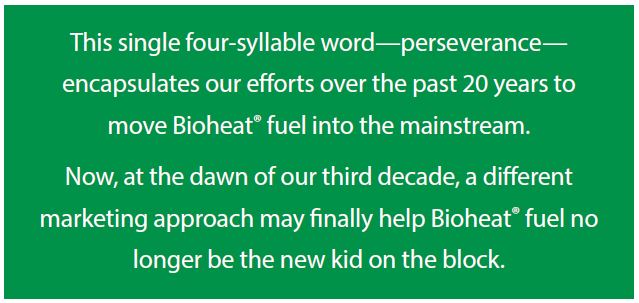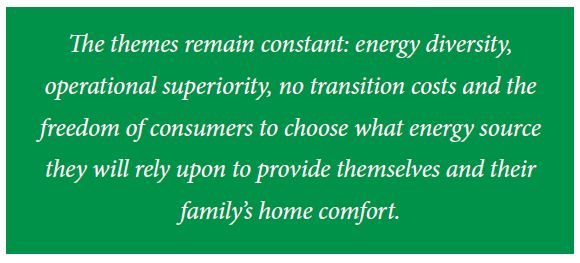Written on: November 9, 2023 by Paul J. Nazzaro

We have all been there, where nothing seems to be working and there’s no light at the end of the tunnel. Against all odds, you find the strength to take one more step—the resolution to persevere. Perseverance becomes an act of pure will against logic and common sense. To persevere is to keep trudging in place when any rational person might have otherwise quit, with the hope and faith of moving forward eventually, even if just a fraction of an inch.
I frequently reflect on biodiesel’s storied timeline of development. It has long been known that Rudolf Diesel ran his early namesake compression-ignition engine on peanut oil in the late 19th and early 20th centuries. By the 1930s, there was interest in splitting vegetable oils to produce a less viscous engine fuel. Moving into the 1940s, reports of what we now call “biodiesel” being used in several countries during World War II ended with wider petroleum availability after the war.
Fast-forward to the late 1980s, and a growing surplus of soybean oil in the U.S.—a result of increased soybean processing and growing demand from the animal-feed industry for soybean meal over whole beans—became a drag on soy prices and was hurting farmers and their livelihood. A movement started to find potentially high-volume industrial uses for all this surplus soybean oil. The term “soy diesel” (stylized as SoyDiesel) was coined and took root. The first known manufacturing of soybean oil-based biodiesel in the U.S. occurred under humble beginnings in Kansas City, MO, in 1991.
In 1992, the National SoyDiesel Development Board was formed by the Missouri Soybean Merchandising Council to find greater use for mounting stocks of this byproduct from soybean processing, as low-volume markets such as salad dressing and mayonnaise were not enough to put a dent in the huge volumes amassing in storage tanks across the Midwest. Two short years later, that group evolved into the National Biodiesel Board and for the next decade and a half, a Wild West-like period of rapid growth in biodiesel development and eventual commercial production ensued, transforming the energy landscape in interesting ways.
Between these time frames, R.W. Beckett completed lab tests of biodiesel blends in an oil burner. Just this year, Beckett commercially released its UL-listed B100 burners and fuel pumps. The move from early lab tests on low-level biodiesel blends to selling UL-approved B100 burners and pumps is enormous progress. Such headway can only be made through perseverance. Editors note: Carlin Combustion Technology announced the release of B100 burners as this issue went to press.
In 2002, the fuel-quality standard ASTM D6751 was published. This was the beginning of nearly two dozen revisions as biodiesel quality evolved from compromised in its early days to exceptional and ratable today, again leveraging the perseverance of scientists and Industry leaders willing to deliver a cleaner-burning liquid fuel to the marketplace. In 2008, the heating-oil specification ASTM D396 allowed up to 5% biodiesel (B5) in conventional heating oil; in 2015, this was expanded to include B6-B20 fuel grades. The industry was evolving, and quickly.
I would be remiss not to mention that the Bioheat® fuel vision was established in 2003, first conceived in my basement and further developed thanks to important collaboration with colleagues and backing from the National Biodiesel Board (now Clean Fuels Alliance America), as well as national and State soybean boards. In 2006, the registered trademark for Bioheat® fuel was secured and since has adopted Plus and Super Plus in order to reference higher and higher blend levels.
Jumping ahead, our industry convened in 2019 and unanimously agreed to voluntarily commit to decarbonize so that a brighter and more secure future could be realized. That commitment—the Providence Resolution—remains intact, and it is the perseverance of many that makes this reality the focal point of our future success.
Throughout the past 30 years, I have witnessed firsthand perseverance exemplified by many individuals and companies, all working together to keep a seat at the 21st Century energy-supply table. Saying this endeavor has been challenging, frustrating and often fatiguing would be an understatement of epic proportions. Would it have been an easier journey if the thousands of companies that make up the oilheat nation joined readily with the early visionaries? Certainly. This, however, was not the case.
Even today, 20+ years in, just a small percentage of fuel dealers actually blend biodiesel into their home heating oil offering. The good news is that this minority of dealers makes up the industry’s largest volume. Hopefully, in the next year or so, with our continued perseverance, the pendulum will swing and it will be all for one and one for all.
Just writing about perseverance helps me keep motivated, focused and hopeful that our most recent endeavor to share the Bioheat® fuel value proposition with consumers will be what’s needed to turn heads and get this movement the attention it deserves after persisting for two decades.
Six months ago, Clean Fuels asked if we could take a different trajectory to help heating-oil nation tell this great story. Even the most committed Bioheat® fuel dealers are at times reticent to talk about the new and improved fuel for a multitude of reasons only they themselves can share. Reflecting on the past decade of our product-development investments to promote Bioheat® fuel, I thought about where we had been first.

Collectively, Clean Fuels members and the National Oilheat Research Alliance (NORA) have invested millions of dollars in education, consumer outreach and technical improvements in both the fuel itself and the equipment in which the fuel is stored, delivered and consumed. Bioheat® Playbooks, websites, print and digital materials, outdoor media campaigns, radio, television, billboards, conferences, sponsorships, branding, consumer-focus groups and much more were developed and disseminated over the years. The missing link with these investments remains a dealer who is “ready, willing and able” to back up the brand with honest face-to-face communication with their customers. That is what ultimately cements the relationship and what the consumer will adopt, because of the trust they have in their supplier.
Now what? After all these concerted efforts with incommensurable results, how can we truly begin to make a real difference? We have a 21st Century low-carbon fuel, the most technologically advanced, modern equipment to combust it in and OEM acceptance on many levels. Our leadership is driving change politically but our capital deficiency to invest in messaging simply comes up short.
Enter “the influencer”
An influencer is an individual with the power to affect buying habits and decision-making of consumers due to their expertise and relationship with their audience. They have a large social media following and create content that generates significant engagement. Through a collaborative effort between Clean Fuels and a notable influencer-resource group, we have entered into an agreement to secure an influencer that we feel best represents our brand—one that has the authenticity and fan base to share the Bioheat® fuel advantages we all know and love.
The journey to identify and select that individual was well planned, thoughtful and deliberate. Starting soon you will hear a lot from this influential person who, after several encounters with our team, gets it and loves it.
Our plan is to work with this individual and engage the consumer population through a well-defined and thought-out paid digital media campaign. To date, several energy groups from Massachusetts, Connecticut, Rhode Island, New York and Pennsylvania are considering joining our collaboration to invest their funds for exclusive use in their States as we prepare to embed our value-added story directly to the consumer. The themes remain constant: energy diversity, operational superiority, no transition costs and the freedom of consumers to choose what energy source they will rely upon to provide themselves and their family’s home comfort.
When sharing the Bioheat® fuel story with our influencer, it became clear to me and those on my team that they exemplify perseverance. They’re not the type of person who gives up. They value our story and understand we are working hard to protect our family businesses and the industry at large.
Ultimately, with this influencer program, we will unleash all the successes we have amassed over the past two decades and bring the story to the customer. My recommendation to you, the average heating oil dealer, is to be prepared to follow up. An existing or future customer of yours may be calling to ask, “Do you sell Bioheat® fuel?” What will your response be? ICM

